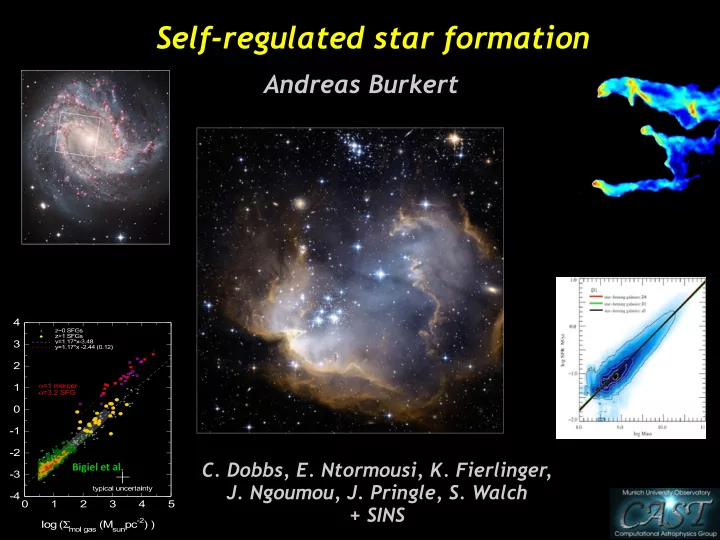

Self-regulated star formation Andreas Burkert C. Dobbs, E. Ntormousi, K. Fierlinger, Bigiel ¡et ¡al. ¡ J. Ngoumou, J. Pringle, S. Walch + SINS
Munich
Santa Cruz
Evidence for self-regulation SFR = M H 2 with τ sf ≈ 1 − 2 ⋅ 10 9 yrs τ sf Genzel et al. 11 • τ sf is almost independent of redshift • Gas depletion timescale 50 times greater than local free-fall timescale. τ ff τ sf < τ Hubble continuous replenishment Bouché et al. 07, McKee & Ostriker 08, Genzel et al. 10,11, Daddi et al. 10
Turbulence in the ISM z=2 [ ] σ km / s (Dib, Bell & Burkert 2006) (Genzel et al. 10,11) z=0 SFR/Area
Numerical simulations of the molecular web ( Dobbs, Burkert & Pringle 11a,b) • 3d SPH simulations (Bate et al. 95) • Fixed galactic gravitational potential (stellar disk + halo) • Self-gravity of the gas component included • Calculations with and without an additional 2 or 4 armed spiral potential • Heating (supernovae + FUV background) • Cooling : radiative + gas-grain energy transfer + recombination on grains • Stars form when a local molecular region collapses and its density exceeds n crit = 250 cm − 3 • A fraction ε of the gas is assumed to turn into stars that heat the environment with an energy (winds and SN) of E SN = ε M dense ⋅ 10 51 ergs ε ≈ 2 − 5% 160 M
Calculation with 5 % efficiency Dobbs, Burkert & Pringle 11a,b
Filamentary interarm features (spurs) Dobbs, Burkert & Pringle 11a,b
Feedback puffs up disks Dobbs, Burkert & Pringle 11a,b
Star formation timescale SFR = M H 2 with τ sf ≈ 1 − 2 ⋅ 10 9 yrs τ sf τ sf
Gas mass fraction and volume filling factor: 5% efficiency
1. Collisions by local gravitational instability and irregular gas motions generate massive clouds and drive internal turbulence
2. Stellar feedback disperses clouds and drives irregular gas motions in the molecular web.
The molecular web Schneider et al. 2010
Gravitational instabilities and star formation timescale + n ( t ) ( ) with τ = 2 ⋅ 10 7 yrs ρ ρ 0 exp t / τ
Gravitational disk instabilities (Toomre 1964; Goldreich & Lynden-Bell 65; Elmegreen 94; Kim & Ostriker 01, 06) Gaseous disks will self-regulate themselves into a state of marginal stability ( Dekel et al. 09; Bournaud et al. 09; Krumholz & Burkert 10; Elmegreen & Burkert 10; Genzel et al. 10, Burkert et al. 11; Dobbs et al. 11a,b ) Q ≡ κσ π G Σ ≈ 0.68...1 κ = 2 Ω
Growth rate of gravitational instabilities: σ ( ) -1 → τ Toomre = 0.1 ⋅τ orb ≈ 2 ⋅ 10 7 yrs π G Σ = κ − 1 = τ Toomre = 2 Ω Q = 1 τ orb R vir H − 1 V vir τ SF ≈ 10 9 yrs ≈ 50 ⋅ τ Toomre ≈ τ Toomre / ε Gravitational instabilities affect galactic disk evolution What determines the star formation efficiency?
Gas velocity dispersion SN driven SN driven Gravity Gravity driven driven
What determines the star formation efficiency? SN driven SN driven Gravity Gravity driven driven
Higher gas surface densities/gas fractions Q = 1 → σ / v rot f gas SN driven Gravity Gravity driven driven The gravity driven mode becomes more dominant for higher gas fractions.
Properties of z=2 fast rotating disk galaxies Tacconi et al. (2010) • Very high molecular gas fractions • High velocity dispersions • Dominated by massive clumps
Gravity driven mode: formation of giant clumps
Fraction of retrograde clouds Q driven supernova driven
-7 -8 -9 y -10 -11 2 kpc -1 0 1 2 3 4 x Genzel et al. (2011) High-z disks: Q-driven mode?
-7 -8 -9 y -10 -11 2 kpc -1 0 1 2 3 4 x Genzel et al. (2011) 2 High-z disks: Q-driven mode? 1 Rotationally supported minidisks 0 z v rot ≈ 200km / s Expected: -1 -2 v rot ≈ 10 − 40km / s Observed: -1 0 1 2 3 4 x
Summary • The molecular web is regulated by gravitational instabilities and stellar feedback. • The star formation timescale is set by the timescale of global disk instabilities and the efficiency of star formation. • In the gravity-driven mode turbulence is regulated by Q ≈ 1 leading to massive , rotating cloud complexes and massive star clusters • In the feedback-driven mode turbulence is regulated by stellar feedback leading to Q>1 and a power-spectrum of cloud masses, with highly turbulent clouds and negligible rotation . Galaxies might prefer to live in the transition region from gravity-driven to stellar feedback driven turbulence star formation efficiency
Recommend
More recommend